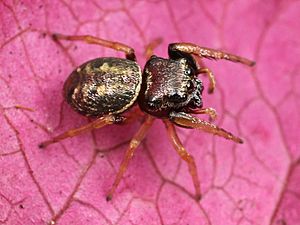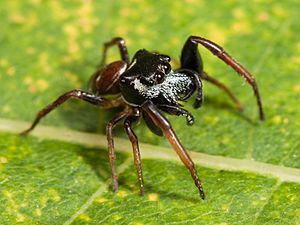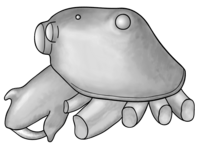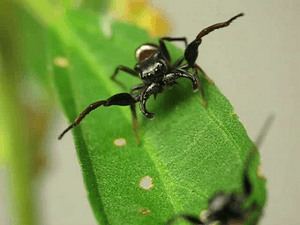Zygoballus sexpunctatus facts for kids
Quick facts for kids Zygoballus sexpunctatus |
|
|---|---|
 |
|
| Female | |
 |
|
| Male | |
| Scientific classification | |
 |
|
| Z. sexpunctatus lives in the southeastern United States. | |
| Synonyms | |
|
Attus sexpunctatus Hentz, 1845 |
The Zygoballus sexpunctatus is a type of jumping spider. You can find it in the southeastern United States. These spiders like to live in grassy areas. Adult spiders are small, about 3 to 4.5 millimeters long. That's about the size of a few grains of rice!
Their bodies are usually bronze or black. Their legs can be reddish-brown or yellowish. Male spiders have special, larger mouthparts called chelicerae. These are used for grabbing food. They also have bigger front leg segments called femora. Like many jumping spiders, males do special dances to attract females. They also have unique ways of showing off to other males.
Contents
What's in a Name?
The name sexpunctatus comes from two Latin words. Sex means "six" and punctum means "spot". This name refers to the six spots often seen on the male spider's back part of the body.
Spider History
A scientist named Nicholas Marcellus Hentz first described this spider. He wrote about it in 1845. He called it Attus sexpunctatus back then.
Later, in 1888, two other scientists, George and Elizabeth Peckham, changed its name. They renamed it Zygoballus sexpunctatus. This was when Zygoballus became its own group of spiders. You can find specimens of this spider in big museums. These include the Museum of Comparative Zoology and the American Museum of Natural History.
The Zygoballus group has about twenty different spider species. They live from the United States all the way to Argentina. These spiders are part of the Salticidae family, which are all jumping spiders.
What Does It Look Like?
Female Z. sexpunctatus spiders are usually 3.5 to 4.5 mm long. Males are a bit smaller, from 3 to 3.5 mm. However, some older descriptions say males can be up to 4.5 mm.
The front part of the spider's body, called the cephalothorax, is bronze or black. It's shaped a bit like a box. Many tiny white or pale blue scales cover its "face" area. These scales also go around the sides of its body.
Male spiders have very large chelicerae, which are their mouthparts. Each chelicera has a strong tooth and a long, curved fang.
Their legs are usually reddish-brown or yellowish. The front legs are darker and thicker, especially on males. These front legs have long spines underneath. In females, the fourth pair of legs is the longest. Males also have small feelers near their mouth, called pedipalps.
The back part of the spider's body, the abdomen, is bronze to black. It often has a white band at the front. It also has two white bands across it. These bands are often broken up into six white spots. Sometimes, these spots might be missing.
This spider looks a lot like another species, Zygoballus rufipes. They live in some of the same areas. You can tell the male Z. sexpunctatus apart by a large white spot on its back. The female can be identified by a special part of her body called the epigyne.
Where They Live
These spiders live from New Jersey down to Florida and west to Texas. They are most common in the southern states. Scientists have found them in many different places. These include old fields, river forests, and pine forests. They also live in grassy areas and even rice fields. You can often find them among grasses and other short plants. Scientists often use a special sweep net to catch them.
Behavior
Male Zygoballus sexpunctatus spiders do special dances to impress females. When a male gets close to a female, he often lifts his front legs. He also spreads them out and wiggles his abdomen. If the female likes him, she might wiggle her abdomen too. Each spider might have a slightly different dance.
Males also have special ways of "fighting" when they meet other males. This showing-off behavior can look similar to their courtship dances. They might lift their front legs and wiggle their abdomen. They also extend their pedipalps and fangs. But these fights are usually not deadly.
What They Eat
Like most spiders, Zygoballus sexpunctatus eats whatever small creatures it can catch. Their diet usually includes small insects. They often eat aphids and young caterpillars. They also eat mosquitoes and other small spiders.
Some wasps hunt these spiders. The wasps sting and paralyze the spiders. Then they take them back to their nests to feed their babies.
Life Cycle
In one study, baby Zygoballus sexpunctatus spiders hatched from their egg sacs in the middle of summer. The spiders then spent the winter as young, not yet adult, spiders. They became fully grown adults around late April.













